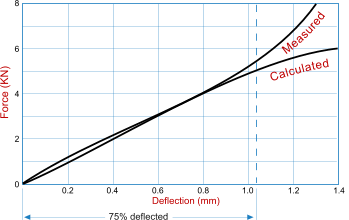Actual Test Results versus Calculated Disc Spring Characteristics
The example, in the graph on the left, is typical of most disc springs, and underlines the necessity of limiting maximum deflection to 75 per cent to avoid sharply increasing force and stress characteristics.
As the compressed disc spring nears its ‘flattened’ condition, the reducing cone angle results in the movement of bearing point toward the centre, thus effectively shortening the ‘lever’ length and ‘stiffening’ the spring.



